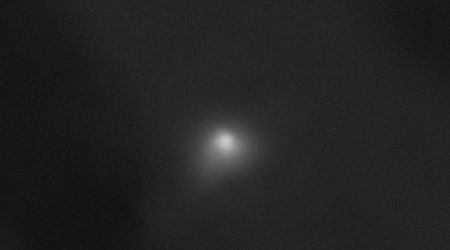Astronomers uncover 'cosmic fossil' galaxy offering glimpse into early universe's seven-billion-year history

Astronomers have made a groundbreaking discovery: a remarkably undisturbed galaxy, dubbed a "cosmic fossil," that has remained virtually unchanged for an astonishing seven billion years. This celestial relic, known as KiDS J0842+0059, offers a striking window into the universe's early evolution, much like dinosaur fossils on Earth provide insights into ancient life. Located three billion light-years away, KiDS J0842+0059 represents a rare class of galaxies that have somehow evaded the gravitational pull and destructive collisions common in the cosmos. This pristine state makes it an invaluable "time capsule" for researchers studying the formation and development of the earliest galaxies, as reported on Space.com.
🚨 Frozen in Time: Astronomers Find Rare Fossil Galaxy
— History Content (@HistContent) June 30, 2025
Astronomers have unveiled KiDS J0842+0059, a galaxy locked in time for an astonishing 7 billion years—a true “cosmic fossil.” Located about 3 billion light‑years away, this massive, compact galaxy (~100 billion solar… pic.twitter.com/3Ek9krLsHh
Recent analysis, primarily utilizing data from the Large Binocular Telescope (LBT), confirmed the galaxy's extraordinary stability. "We have discovered a galaxy that has been 'perfectly preserved' for billions of years, a true archaeological find that tells us how the first galaxies were born and helps us understand how the universe has evolved to this day," stated Crescenzo Dove, co-leader of the research team and a National Institute for Astrophysics (INAF) researcher. He liked these fossil galaxies to "dinosaurs of the universe," providing crucial clues about their formation environments and the subsequent evolution of today's massive galaxies.

KiDS J0842+0059 was initially identified in 2018 by the KiDS (Kilo Degree Survey). Subsequent observations with the Very Large Telescope Survey Telescope (VST) and the Very Large Telescope (VLT) refined measurements of its size and mass. These investigations revealed that while the galaxy possesses a stellar mass approximately one hundred billion times that of our Sun, it is unusually compact for its mass and has largely ceased forming new stars throughout its existence.

To eliminate any ambiguities regarding KiDS J0842+0059's characteristics, particularly its dimensions and structure, the team employed the LBT's adaptive optics system. This cutting-edge technology yielded images with ten times the detail of previous observations, solidifying the galaxy's status as a true relic. "Data from the LBT have allowed us to confirm that KiDS J0842+0059 is indeed compact and therefore a true galaxy relic with a shape similar to NGC 1277 and the compact galaxies we observe in the early stages of the universe," explained Chiara Spiniello, team member and a researcher at the University of Oxford. "This is the first time that we have been able to do this with such high-resolution data for a galaxy relic so far away."
NGC 1277, another example of a stunted galactic fossil, is considerably closer, situated within the Perseus Cluster approximately 240 million light-years away. The findings of this pivotal research were recently published in the Monthly Notices of the Royal Astronomical Society. The existence of galaxies like KiDS J0842+0059 and NGC 1277 suggests that some galaxies can form rapidly, maintain a compact structure, and remain dormant for billions of years by skillfully avoiding galactic collisions, as mentioned by the outlet.

"Studying these cosmic fossils helps us reconstruct the formation history of the nuclei of today's massive galaxies, which — unlike relic galaxies — have undergone fusion processes, accreting matter right around those first compact galaxies from which they originated," remarked another team member, Tortora. "With cutting-edge technologies such as adaptive optics and the support of telescopes such as the LBT, we can improve our understanding of this type of galaxy." The team anticipates further breakthroughs by searching for and studying new relic galaxies using the exceptional quality and high-resolution data from the upcoming Euclid space telescope.









